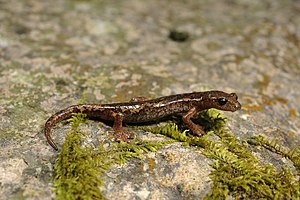Ambrosis cave salamander
| Ambrosis cave salamander | ||||||||||||
|---|---|---|---|---|---|---|---|---|---|---|---|---|

Ambrosis cave salamander |
||||||||||||
| Systematics | ||||||||||||
|
||||||||||||
| Scientific name | ||||||||||||
| Hydromantes ambrosii | ||||||||||||
| Lanza , 1955 |
Ambrosis cave salamander ( Hydromantes Ambrosii , Syn. : Speleomantes Ambrosii ) is a salamander from the family of the lung lots Salamander (Plethodontidae). Its distribution area is in Italy .
features
Adults are about 9 to 12 cm long, with the females being slightly longer than the males. The oval head is about an eighth of the total length and the tail is almost half of the total length. The body coloring and drawing is variable and can include various shades of brown, gray, ocher and yellow. Often there are lighter spots on the basic color. The belly side is darker than the back side. Many individuals have a partly continuous, partly interrupted light ocher-yellow stripe on the back edges, which is particularly pronounced in animals in the La Spezia area ( Hydromantes a. Ambrosii ). Adult animals have ear glands ( parotids ) on each side of the head .
Cave salamanders have no lungs, the necessary gas exchange takes place via the oral cavity and the skin. It is therefore important that the skin is always moist, and the animals need a relative humidity between 80 and 100%.
confusion
A distinction between the Ligurian cave salamander and the Italian cave salamander on the basis of external characteristics is very difficult. The easiest way to determine it is via the location.
distribution
The species has a small distribution area in northwest Italy, which is divided into two disjoint areas. The distribution is limited to the Italian regions of Tuscany and Liguria , here the species mainly lives in the Apennines near the cities of La Spezia and Massa and occurs from almost sea level to 1730 m above sea level.
The habitat consists of coniferous, deciduous and mixed forests, but also scrubland or sparsely overgrown rocky terrain. The species lives in hiding places in rocks or the ground.
Way of life
Seasonal activity is concentrated in the period from spring to summer and then again in autumn. The animals are nocturnal and can usually only be found on the surface of the earth during or after rain. During the day they are mostly hidden under stones and in cavities such as crevice systems and caves. In winter they only become active occasionally at higher temperatures and mostly hibernate. The food, consisting of small invertebrates, is preyed on with a flunging tongue. In favorable weather conditions, they are above ground on the ground looking for food or waiting for piles of stones, rocks or walls for prey.
Danger
The species is common in its range, but sensitive to human impact due to its small area.
Subspecies
The subspecies H. a. bianchii inhabits the southern part of the province of Massa-Carrara and remains east of the Magra River . H. a. ambrosii is found west of the Magra River, in the province of La Spezia .
Taxonomy
Ambrosi's cave salamander used to be united with the Ligurian cave salamander in one species. Later the species were separated from one another mainly on the basis of genetic data. The name Hydromantes ambrosii was chosen in honor of the Italian historian and archaeologist Augusto Cesare Ambrosi (1919-2003), the discoverer of the species.
Individual evidence
- ↑ Dieter Glandt: The amphibians and reptiles of Europe: All kinds in portrait. 2nd, updated and expanded edition. Quelle & Meyer, Wiebelsheim 2015, ISBN 978-3-494-01581-1 .
literature
- Dieter Glandt: The amphibians and reptiles of Europe: All kinds in portrait. 2nd, updated and expanded edition. Quelle & Meyer, Wiebelsheim 2015, ISBN 978-3-494-01581-1 .
- Sebastiano Salvidio: Life history of the European plethodontid salamander Speleomantes ambrosii (Amphibia, Caudata). In: Herpetological Journal. Volume 3, 1993, pp. 55-59.
- Giuseppe Nascetti, Roberta Cimmaruta, Benedetto Lanza, Luciano Bullini: Molecular Taxonomy of European Plethodontid Salamanders (Genus Hydromantes). In: Journal of Herpetology. Volume 30, No. 2, 1996, pp. 161-183, doi: 10.2307 / 1565507 .
Web links
Hydromantes ambrosii on amphibiaweb.org